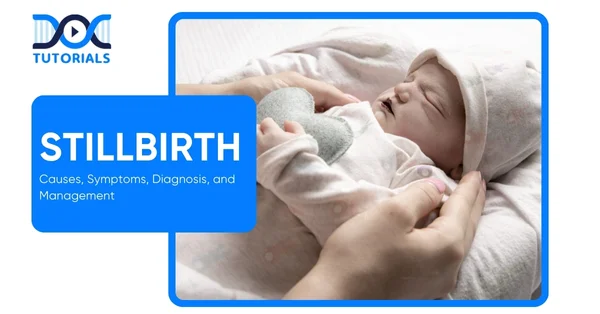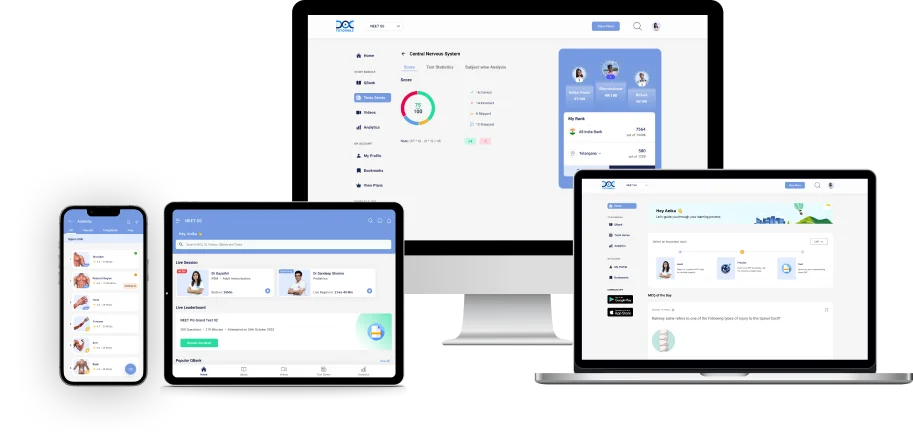Stillbirth: Causes, Symptoms, Diagnosis, and Management

A stillbirth is an obstetric complication that happens when the fetus passes after 20 weeks of gestation in the womb or during labour. This is different from miscarriages, which include early pregnancy loss and sudden infant death syndrome (SIDS), in which the baby dies soon after birth.
A study conducted in 2021 stated that India’s stillbirth rate is 24.7 per 1000 births for pregnancies of 20 weeks or more and 17.4 per 1000 for pregnancies of 28 weeks or more. Therefore, it is essential to understand the concept of stillbirth, especially if you are an aspiring medical student preparing for the NEET PG exam.
Keep reading to understand stillbirth, its causes, symptoms, diagnosis and management.
What is Stillbirth?
A stillbirth definition, also known as intrauterine fetal demise (IUFD), happens when the fetus passes away after 20 weeks of conception. The infant’s death is characterised by the absence of heartbeat or movement in the womb.
It is considered one of the most tragic consequences in obstetrics and can happen before or during labour, even in pregnancies that are considered healthy. Stillbirths are classified based on the period of gestation during which the unborn fetus passes away.
The classification is given below:
- Early Stillbirth: Between 20 and 27 weeks
- Late Stillbirth: Between 28 and 36 weeks
- Term Stillbirth: At or after 36 weeks of gestation
Countries across the world provide different definitions of stillbirth. India follows the WHO (World Health Organisation) guidelines, where the cut-off time after which the death of the fetus is considered stillbirth is 20 weeks. Accordingly, a miscarriage is the death of the fetus before 20 weeks.
What are the Causes of Stillbirth?
The cause of stillbirth is unknown in many cases, particularly because it can occur due to multiple factors and does not have one underlying cause. Several common factors have been identified through testing.
Common causes of stillbirth include:
- Pregnancy and Labour Complications: Factors such as prolonged labour, obstructed labour, or uterine rupture can harm the well-being of the fetus.
- Placental Abruption: When the placenta, vital for oxygen and nutrient supply, detaches from the uterus too early, it can compromise the fetus’s life.
- Pre-eclampsia: A hypertensive disorder, where the mother experiences persistent high blood pressure during pregnancy.
- Antepartum Haemorrhage: Bleeding before or during birth leading to fetal hypoxia and death.
- Umbilical Cord Accidents: Cord prolapse (cord exits the cervix before the baby, proper knots (cord forms an actual knot on itself) or nuchal cords (umbilical cord wraps around the baby’s neck). This can cut off the blood and oxygen supply.
- Intrahepatic Cholestasis of Pregnancy (ICP): Severe itching caused by a liver disorder.
- Congenital anomalies: Severe genetic or structural defects like anencephaly (infants with an underdeveloped brain or an incomplete skull) and chromosomal abnormalities.
- Infections: Maternal, placental or fetal infections, especially E.coli, group B strep or enterococcus before 24 weeks.
- Substance Use: Use of tobacco, alcohol or other recreational drugs by the mother.
- Psychosocial Stress: Harsh and challenging living conditions can lead to fetal distress or other complications.
- Maternal Age Factors: Teenagers and individuals aged 35 or older can also increase the risk.
- Underlying Health Conditions: Chronic conditions of the mother, such as diabetes, hypertension, thyroid disorders, obesity (BMI >30), lupus, and blood-clotting disorders.
While stillbirths can happen in any pregnancy, certain maternal, environmental or lifestyle factors can increase the risk. Identifying and managing these factors is key to preventing preventable stillbirths.
What are the Symptoms of Stillbirth?
In many cases of stillbirth, the expecting mother doesn’t even realise or rarely displays any symptoms. However, there are some warning signs that one should be wary of:
- Lack of fetal movement is seen as the first or most common sign.
- Not being able to hear the fetus’s heartbeat.
- Unexplained vaginal bleeding or leakage of amniotic fluid.
- Cramps or contractions in the uterus are also described by patients as a tightening of the belly.
These symptoms are not conclusive of stillbirth and are seen in other pregnancy complications as well. However, if these signs are detected, immediate medical attention should be sought, and further evaluation, including ultrasound and monitoring of fetal heartbeats, should be conducted.
What is the Diagnosis of Stillbirth?
The steps that explain the diagnosis of stillbirth are as follows:
| Steps | Explanation |
| Clinical Suspicion (First Signs that Raise Concerns) | Real-time ultrasound confirms the absence of fetal cardiac activity. It allows direct visualisation of the fetal heart. Imaging can be technically challenging, particularly in the presence of maternal obesity, abdominal scars and oligohydramnios. |
| Ultrasound Evaluation | Real-time ultrasound confirms the absence of fetal cardiac activity. It allows direct visualisation of the fetal heart.Imaging can be technically challenging, particularly in the presence of maternal obesity, abdominal scars and oligohydramnios. |
| Other Approaches | In addition to the absence of fetal cardiac activity, Other secondary symptoms, such as collapse of the fetal skull with overlapping bones, hydrops, or maceration resulting in an unidentifiable fetal mass, may be observed. Another characteristic linked to stillbirth that may reduce the clarity of real-time imaging is the presence of intrafetal gas in the heart, blood vessels, and joints. |
| Post-diagnosis Evaluation | Blood tests for the mother, checking the placenta, and sometimes a fetal autopsy (if parents agree) help find the cause. |
How is Stillbirth Managed and How are Families Supported?
With the diagnosis of stillbirth, the first line of action is to deliver the infant, prioritising the mother’s safety physically and emotionally. The management options include:
1. Induced Labour
In most cases, doctors recommend inducing labour as one of the safest and most effective methods. This refers to prescribing medications to start the delivery process, mainly when no immediate medical emergency exists. Labour usually begins within a day or two of diagnosis unless the mother wants more time.
2. Waiting for Natural Labour
Sometimes, doctors may allow natural labour to begin independently, especially if the mother is stable and prefers to wait. Labour usually starts spontaneously after the fetal demise and therefore must be carefully monitored. Blood tests are performed regularly to detect clotting issues or infections.
Waiting is usually avoided if there are complications like:
- Pre-eclampsia (high blood pressure)
- Infection
- Heavy bleeding
- History of clotting disorders
3. Caesarean Section (C-section)
After a stillbirth is diagnosed, a C-section is typically not advised unless:
- The mother has already undergone uterine surgery or a C-section.
- The infant is positioned abnormally.
- No progress in labour is seen.
- Vaginal delivery is unsafe.
4. Emotional Support and Communication
Because late intrauterine fetal demise (IUFD) is frequently abrupt and unanticipated, it presents unique challenges. Determining the mother’s and her partner’s emotional requirements and feelings is essential.
Delivering the diagnosis should be done with empathy and clarity, explaining the situation clearly. Validation of the parents’ grief is crucial, and referrals to grief counsellors, peer-support groups, or mental health professionals are often provided.
5. Postpartum Investigations and Future Planning
After delivery, investigations are essential to understand the cause and plan for future pregnancies. These include:
- Placental and fetal examination, including histopathology
- Autopsy of the fetus if the parents consent
- Diagnostic tests for the mother to rule out infections or clotting disorders.
- Reviewing results and implications for future pregnancies
- Providing preconception advice, such as smoking cessation, weight management, and genetic counselling
- Planning specialised monitoring in future pregnancies (e.g., early scans, growth surveillance)
FAQs about Stillbirth
1. How is stillbirth prevented?
As the definite cause of stillbirth is unknown and it is an obstetric condition with multifactorial causes, not all stillbirths are preventable. However, several steps can reduce the risk:
- Attending regular check-ups to monitor maternal and fetal well-being
- Managing chronic maternal conditions like diabetes, hypertension, and thyroid disorders
- No smoking, drinking, or substance abuse
- Monitoring fetal movements, especially after 28 weeks of gestation
- Taking precautions if there is vaginal bleeding, fluid leakage, or reduced fetal activity
Preventive strategies also include maintaining good nutrition, managing stress effectively, and accessing quality prenatal care.
2. Is it possible to have a healthy pregnancy after a stillbirth?
It’s a traumatic experience, and it’s completely understandable to have concerns about a future pregnancy. After a stillbirth, doctors often conduct a thorough evaluation to try to understand what happened. Based on the findings, preconception counselling and a more frequent monitoring schedule are involved to minimise the risk of recurrence.
3. How is fetal movement monitoring helpful in preventing stillbirth?
Monitoring fetal movements after 28 weeks is an effective method to understand fetal health. A decrease or absence of movements can be an early warning sign of fetal distress.
Doctors recommend the “kick count” method, which refers to counting how long it takes to feel 10 movements. If movements decrease or stop, an immediate nonstress test (NST) or ultrasound is needed to rule out fetal compromise and intervene promptly.
Conclusion
Stillbirth is a traumatic and complex obstetric condition with multiple causes. Therefore, precaution of stillbirth often involves identification of the risk factors and performing regular antenatal monitoring.
Beyond making the diagnosis, doctors must approach families with empathy and support, helping them cope with the grief and shock of stillbirth. This kind of care relies on a solid grasp of the condition, its causes, and the challenges it brings.
For those preparing for the NEET PG exam, knowing the classification, causes, signs, and management of stillbirth is essential for real-life patient care.
DocTutorials provides comprehensive notes, expert guidance, and clinical insights to help you prepare for your NEET PG examinations.
Explore our NEET PG course to enhance your clinical reasoning and conceptual understanding.
Latest Blogs
-

NEET SS Exam 2024: Analysis, Key Dates, Counselling
The NEET SS 2024 exam kicked off on March 29, 2025. Over two days and two slots, candidates across 13…
-

NEET PG Registration 2025: An Essential Guide For Exam Prep
The NEET PG registration, which is conducted online, is a crucial step in the exam process. Filling out the NEET…
-

NEET PG Syllabus 2026: A Must-Have Complete Guide for Exam Success
The NEET PG Syllabus acts as one of the foundation stones for aspiring postgraduate medical students like you who are…




